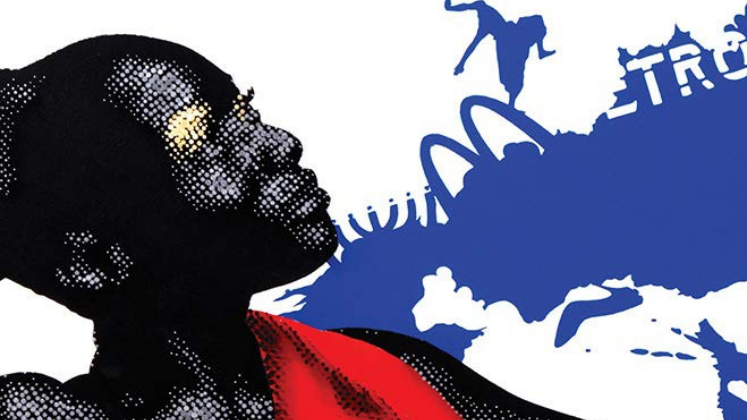 In The Fascist Party and Popular Opinion in Mussolini’s Italy, Paul Corner re-examines the experience of Italy during Mussolini’s fascist regime. Based largely on unpublished archival material, the book concludes by suggesting that the abuse of power by fascists mirrors much wider problems in Italy related to the relationship between the public and the private and to the modes of utilisation of power, both in the past and in the present. Massimo Mangilli-Climpson finds the book contains a well-argued discussion raising a number of new points about the country’s development in the early 20th century.
In The Fascist Party and Popular Opinion in Mussolini’s Italy, Paul Corner re-examines the experience of Italy during Mussolini’s fascist regime. Based largely on unpublished archival material, the book concludes by suggesting that the abuse of power by fascists mirrors much wider problems in Italy related to the relationship between the public and the private and to the modes of utilisation of power, both in the past and in the present. Massimo Mangilli-Climpson finds the book contains a well-argued discussion raising a number of new points about the country’s development in the early 20th century.
 The Fascist Party and Popular Opinion in Mussolini’s Italy. Paul Corner. Oxford University Press. July 2012.
The Fascist Party and Popular Opinion in Mussolini’s Italy. Paul Corner. Oxford University Press. July 2012.
In the early 1970s, Italy topped the charts in industrial disputes. I recall several old-timers nostalgically whispering that conditions were so different when there was order, the trains ran on time, and it was possible to be proud to be Italian after the country’s football team twice became World Cup champions in the 1930s. I wondered if later on they had cheered in April 1945 when Mussolini and his mistress, Claretta Petacci, were hung up at a petrol station in the centre of Milan.
Paul Corner’s The Fascist Party and Popular Opinion in Mussolini’s Italy first questions the old theory that it was the Second World War which brought down the Fascist dictatorship. Even before the killing started in June 1940, Corner, Professor of European History at the University of Siena, feels the Fascist Party (PNF) was experiencing in full what Robert O. Paxton (2004) described as “entropy”, the final stagnant phase of all totalitarian regimes.
By going back to the movement’s origins and his own still pioneering research on Fascism in Ferrara (1974), Corner points to the weaknesses already prevalent before Mussolini’s “March on Rome” in October 1923. The PNF made grandiose claims of establishing a new national centralized system from the grassroots, to replace the old corrupt Liberal democracy which had encouraged local parochial and conflictual politics. On the contrary, the local fascio and provincial “federal” sections had been superimposed onto the local social and economic territory, without effecting any social changes. Unlike Nazism, much evidence showed that there was no homogeneous national image of Fascism; everything was seen through a particular local-provincial orbit.
Until the murder of Socialist leader Giacomo Matteotti in 1924, the intransigents believed that having effected the “Revolution”, and now in power, they had the right and might to run things as they wished and pick up the fruits. Despite needing such thugs, the Duce was astute enough to realise that violence and lively “autonomous” party sections were a personal danger, and that they threatened his own power base, stability and future. With his Party secretaries, Turati, Giurati, and Starace, his response was to subordinate the PNF to the state, and to widen its scope as educator and organizer of the masses through its capillary organizations: the Fascist unions; the Dopolavoro (OND) with its imposing after-work centres; the social insurance, and health and care agencies affecting ordinary peoples’ lives from the cradle to the grave; and the Balilla (ONB) or the youth, and (GUF) university movements.
Corner admits the novelty, the progressive vision and the scale of these schemes in a largely agrarian country. He also notes the impressive, well-organized mobilization in public of mass rallies (he enjoys Bottai’s picturesque expression of the Party herding cattle), as well as the attempt to present a national patriotic image for everything Fascist. However, the weight of evidence and the constant repetitive slant marks him as less as an impartial a-Fascist, and more in the traditional anti-Fascist post-war camp.
The new Party became one of functionaries, who were called upon to repeat like thoughtless children empty emotive dogmatic commands, such as “Believe, Obey, Fight”, as well as enrolling and checking its members. They were never involved in training its cadres for efficient professional public service, nor encouraging political discussion or thought among the population. Throughout the late 1920s and 30s the author shows the local provincial leaders, the federali, the length and breadth of Italy were either in virtual permanent conflict with the central party directorate, or with the state authorities, the prefecture and the comuni, through the figures of the prefect and his non-elected mayoral appointee, the podestà. In contrast to Nazi Germany where the Nazi Party led and the Reichsstatthalter combined both party and state roles, in Italy there was a conflict of functions, with officials eager to expand their powers beyond their duties.
Threats of censure, temporary or permanent suspension, expulsion from the party, or even their banishment to distant, isolated regions, the confino, as Carlo Levi described in his autobiography Christ stopped at Eboli, and their replacement with outsiders – Rome’s “foreign” nominees from outside the province, did not suffice to bring them to heel. They believed, without the fear of a Night of the Long Knives, that even if expelled, they and their supporters would one day succeed in influencing a change from within, with the replacement of higher officials: the prefect, right up to the national party secretary.
Tullio Tamburini, head of the intransigent Florentine squadristi, was expelled in 1925, but later experienced full rehabilitation to political life and even held high ministerial office in the 1930s. Bernando Barbiellini-Amedei, leader in Piacenza, faced expulsion, reinstatement, and then was re-expelled again, all within five years.
Such factional and personal infighting, better known as “Beghism”, not only generated a poor image of the Party and thus the regime, it blocked the flow of funds coming to the administration, preventing the Party from effectively carrying out its prescribed services, so discrediting it further.
Corner’s analytical examination then questions how much more acceptable Mussolini’s 1974 biography, by Renzo De Felice, is after nearly thirty years. The biography affirmed that the height of the regime’s consensus followed the military victory against Ethiopia, and the declaration of the Italian Empire in May 1936. At the time, the Italian anti-Fascist historical and the political left establishment found this idea most repugnant and unacceptable to acknowledge for a right-wing totalitarian system.
With the full use of the party and state apparatus at the regime’s disposal, complete with official party, union, church and turned anti-Fascist informers, as well as OVRA secret police in action, Beneduce’s agency was far from being an amateur lackadaisical version of the Gestapo, (no mention of the NKGB, or the Kempeitai). The people often presented themselves in public and cheered simply because that was ordered, it was what everyone did, and they soon learned the risks of individual dissent could be too great: a beating, the loss of social benefits or a job and with the loss of a home, even serious difficulties for the family. So no one can dispute it as little more than tacit outward expressions of mobilized consent.
Though Corner agrees the Fascist dream for a “place in the sun” in 1935, and the growing closeness with Germany, put the country firmly in the international sphere, he dates the pinnacle of popular consent much earlier: back to 1929, when “Fascist” Italy finally became accepted by the Vatican, and the Catholic Church with the signing of the Lateran Pact. That brief moment of greatness soon vanished in the wake of the seemingly endless economic depression. More so, then, a distinct feeling of “them” and “us” arose: certain Fascists were seen living and eating well in the good local restaurants, misusing official cars in the company of mistresses, all at the expense of the general public. Reports in the Party survive of jealous rivals continuing to inform on federali of selling jobs to the needy unemployed, and tenders for public contracts, and then pocketing the proceeds in a very “un Fascistic behaviour”.
Until 1938 many convinced themselves that Mussolini was different from other Fascists, and in particular from Starace; he was clean of abuse or corruption. Indeed, the expression “se sapesse Mussolini”, or “if only Mussolini knew” was for long banded about. After the initial hurrah when the War was declared, briefly fusing patriotism with national Fascist feeling, fears and gloom started to grip all classes. But it was now the Fascists who voiced their greatest grievances and alarms (Why? Because they felt pay back time was fast approaching?) – including for the lack of air-raid shelters being built in the cities; and with rumours of various plots of leading members of the army and of the monarchy planning to arrest a now less than perfect Duce. Interestingly enough given the prophetic correctness, were reports mentioning Badoglio first in 1939 and again in 1941, but incredibly no action was pursued, and one wonders how history would have unfolded had Badoglio actually been arrested?
Any plans by Party secretary Serena (until December 1941) and for personnel committed to reform the ailing Party and the regime in wartime seemed too little, and much too late. Perhaps Mussolini was too preoccupied to care, though it is important to note that Hitler had his eye on the organised skills of Farinacci as Mussolini’s likely successor, and not Ciano.
Corner underlines, however, that organized successes existed within the expanded parastate outside the Party during the 1930s with the formation of industrial and banking concerns, IRI and IMI, which survived the war in the new Italian Republic, proving the creativity of the Italian totalitarian system both to produce such structures, discover and recruit competent non-political staff.
Returning to the irritated witnesses in the 1970s, as children who came of age under Fascism, a system which carried the seeds not only of the dreaded sixty years of Liberal democracy, but also those further back in its national history, it is obvious not everything of Fascism dissolved like snow in 1943 or 1945. The author emphasizes that sociologists rather than historians have something old or new to explain to us about the nature of political culture that gets passed on, of political castes, or on provincialism, characteristics of the Republic, and even of the separatist Northern League (LN).
This is a well-argued discussion that can either be read separately from or together with Paul Corner’s earlier collection of edited essays Popular Opinion in Totalitarian Regimes.
——————————————————————————————-
Massimo Mangilli-Climpson is a Lettore working in the Department of Economics at Cà Foscari University in Venice, Italy. His most recent book is Larkhill’s Wartime Locators: Royal Artillery Survey in the Second World War (Pen & Sword, 2007). Read more reviews by Massimo.







